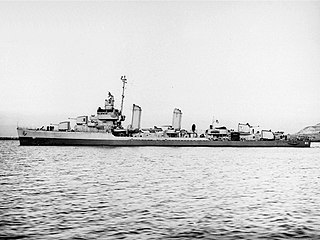
USS Franks (DD-554), a World War II-era Fletcher-class destroyer in the service of the United States Navy, was named after Medal of Honor recipient Acting Master's Mate William Joseph Franks.

USS Hazelwood (DD-531) was a World War II-era Fletcher-class destroyer in the service of the United States Navy The ship was the second named for Commodore John Hazelwood; a naval leader in the American Continental Navy.

USS Dennis (DE-405) was a John C. Butler-class destroyer escort in the service with the United States Navy from 1944 to 1946. She was scrapped in 1973.

USS Helm (DD-388) was a Bagley-class destroyer in the United States Navy during World War II. She was named for Rear Admiral James Meredith Helm. Helm received 11 battle stars for her World War II service in the Pacific.

USS Halsey Powell (DD-686), was a Fletcher-class destroyer of the United States Navy.

USS O'Flaherty (DE-340) was a John C. Butler-class destroyer escort built for the United States Navy during World War II. She was named for Ensign Frank Woodrow O'Flaherty, a pilot who posthumously received the Navy Cross for his actions at the Battle of Midway.

USS Remey (DD-688) was a Fletcher-class destroyer of the United States Navy, named for Rear Admiral George C. Remey (1841–1928).

USS Evans (DD-552), a Fletcher-class destroyer, was the second ship of the United States Navy to be named for Rear Admiral Robley D. Evans (1846–1912).

USS Schroeder (DD-501), a Fletcher-class destroyer, was a ship of the United States Navy, named for Rear Admiral Seaton Schroeder (1849–1922). Entering service in 1943, the ship saw action during World War II, participating in the Battle of Tarawa. Following the war the destroyer was placed in reserve, remaining in this state until 1972. She was sold for scrap in 1974.

USS Charles S. Sperry (DD-697) was an Allen M. Sumner-class destroyer in service with the United States Navy from 1944 to 1973. In 1974, she was sold to Chile, where she served as Ministro Zenteno (D-16). She was finally scrapped in 1990.

USS James C. Owens (DD-776), an Allen M. Sumner-class destroyer, is the only ship of the United States Navy FRAM II class to be named for Lieutenant James C. Owens Jr., a member of Torpedo Squadron 8 on board USS Hornet. His entire squadron was lost in an attack against Japanese aircraft carriers 4 June during the Battle of Midway. Lt. Owens received the Navy Cross and the Presidential Unit Citation (US) posthumously.

USS Longshaw (DD-559), a Fletcher-class destroyer, was a ship of the United States Navy named for Dr. William Longshaw, Jr. (1836–1865), who served in the Navy and was killed during the Civil War.

USS Harrison (DD-573) was a Fletcher-class destroyer of the United States Navy. She was second Navy ship of that name.

USS Cotten (DD-669) was a Fletcher-class destroyer of the United States Navy, named for Captain Lyman A. Cotten (1874–1926).

USS Kalk (DD-611) was a Benson-class destroyer in the United States Navy during World War II. She was the second ship named for Lieutenant Stanton Frederick Kalk.

USS Kyne (DE-744) was a Cannon-class destroyer escort built for the United States Navy during World War II. She served in the Pacific Ocean and provided escort service against submarine and air attack for Navy vessels and convoys. She earned six battle stars during the war.

USS La Prade (DE-409) was a John C. Butler-class destroyer escort in service with the United States Navy from 1944 to 1946. She was scrapped in 1973.

USS LeRay Wilson (DE-414) was a John C. Butler-class destroyer escort acquired by the U.S. Navy during World War II. The primary purpose of the destroyer escort was to escort and protect ships in convoy, in addition to other tasks as assigned, such as patrol or radar picket. Post-war she returned home with four battle stars to her credit.

USS Oliver Mitchell (DE-417) was a John C. Butler-class destroyer escort built for the United States Navy during World War II. Post-war, after active participation in the Pacific War, her crew returned home with five battle stars to their credit.

USS Silverstein (DE-534) was a John C. Butler-class destroyer escort in service with the United States Navy from 1944 to 1947 and from 1951 to 1958. She was sold for scrapping in 1973.




















